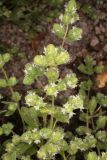Additional notes (click to expand)
Medicinal
Culpeper: ‘Origanum. Organy: a kind of wild marjoram, ... helps the bitings of venomous beasts, such as have taken Opium, hemlock or poppy; provokes urine, brings down the terms, helps old coughs; in ointments it helps scabs and itch.’
Culpeper, Nicholas. (1650). A Physical Directory . London, Peter Cole.
Other use
Notes: It is a culinary herb, but is still widely used as a general tonic in modern herbalism. To quote Plants for a Future: ‘The herb is antiseptic, antispasmodic, carminative, cholagogue, diaphoretic, diuretic, emmenagogue, expectorant, stimulant, stomachic and mildly tonic ...(used) internally in the treatment of bronchial complaints, tension headaches, insomnia, anxiety, minor digestive upsets and painful menstruation.’
Plants for a Future (2017) at www.plantsforafuture.org.uk. http://www.pfaf.org/user/Plant.aspx?LatinName=Origanum+majorana
link
Leaves used for culinary purposes; flavouring for salad dressings, vegetables, oils and tea. The aromatic seeds are used as a flavouring in sweets and drinks.
Plants for a Future (2017) at www.plantsforafuture.org.uk. http://www.pfaf.org/user/Plant.aspx?LatinName=Origanum+majorana
link
Geographical distribution
- Asia-Temperate, Western Asia, Cyprus
- Asia-Temperate, Western Asia, Turkey
Origanum majorana L.
Family: LAMIACEAEGenus: Origanum
Species: majorana L.
Common names: Sweet Marjoram
Pharmacopoeia Londinensis name: Amaracus/Sampsucum
Distribution summary: Cyprus, Turkey
Habit: Perennial
Hardiness: H4 - Hardy; average winter
Habitat: Rocky slopes
Garden status: Currently grown
Garden location: Europe & Mediterranean (E), Pharmacopoeia Londinensis 1618 'Leaves' (HSE 5)
Flowering months: June, July, August, September
Reason for growing: Medicinal, other use
